Review and photos by Bokisaurus
When it comes to suffering from identity crisis, no other extinct species exhibits this more than the mighty Megalodon (Carcharocles megalodon), which is ironic given how popular it is.
This identity crisis is of course due to the fact that very little fossil material is available to help create an accurately restoration of it and that the majority of the restorations, from paleo art to movies, are all based on the extant Great White shark, a species that many believed for years it resembles.
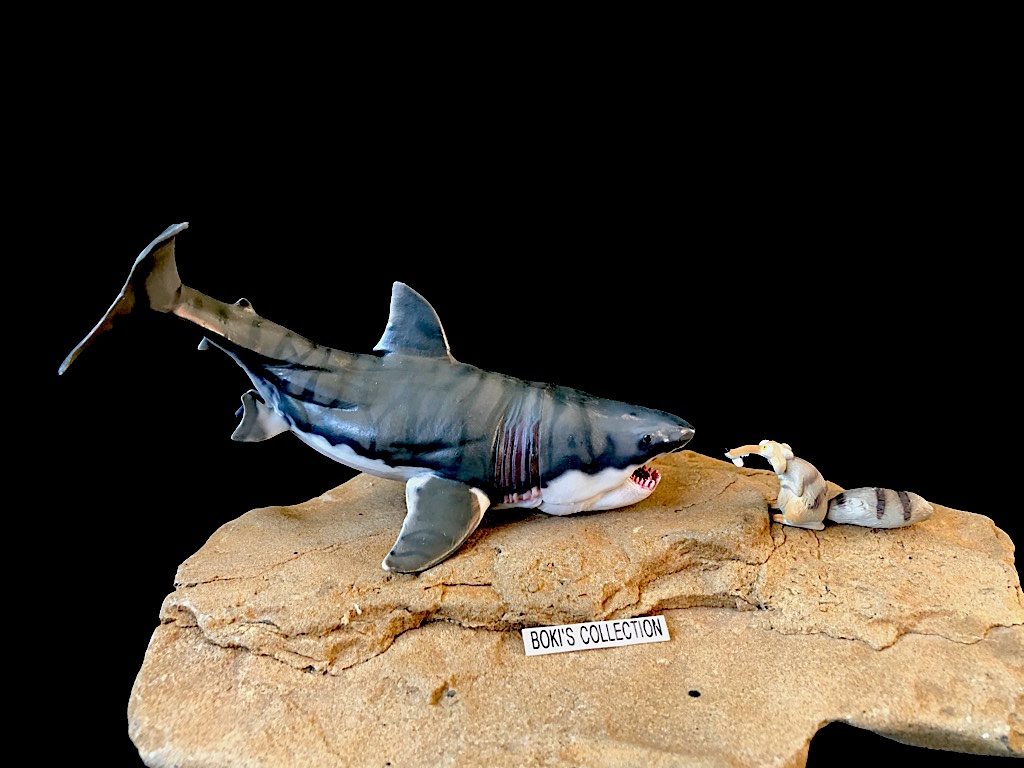
Despite this crisis, Megalodon is the most famous of the extinct sharks, and possibly only surpassed in popularity by the extant Great White that still roam todays oceans. It is the Tyrannosaurus rex of the fish world.But unlike some smaller prehistoric sharks that left some body impressions as well as ubiquitous teeth, Megalodon is only mostly knows from its teeth and a few vertebra.
With only scant fossil material to work with, it is difficult to say with certainty how it may have looked like and it also makes estimating the size difficult, with so many contradictory estimates thrown all over the place, from conservative to the outrageous.
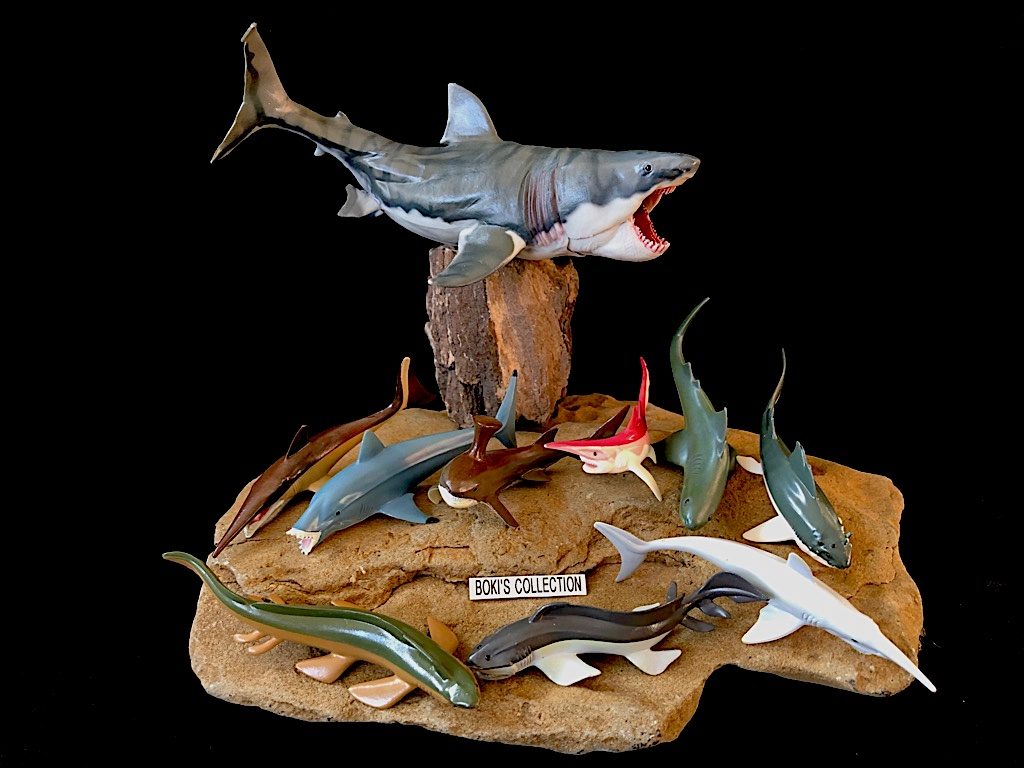
Because of this challenges, the mighty Great white shark is often used as the default basis of reconstruction as well as estimating the size of Megalodon as many feel it is the best analogue.
This explains why most reconstructions of megalodon look just like a Great white shark, only much bigger. This images of Megalodon as a scaled up version of the Great white shark is so popular and powerful that it has become the standard in popular culture.
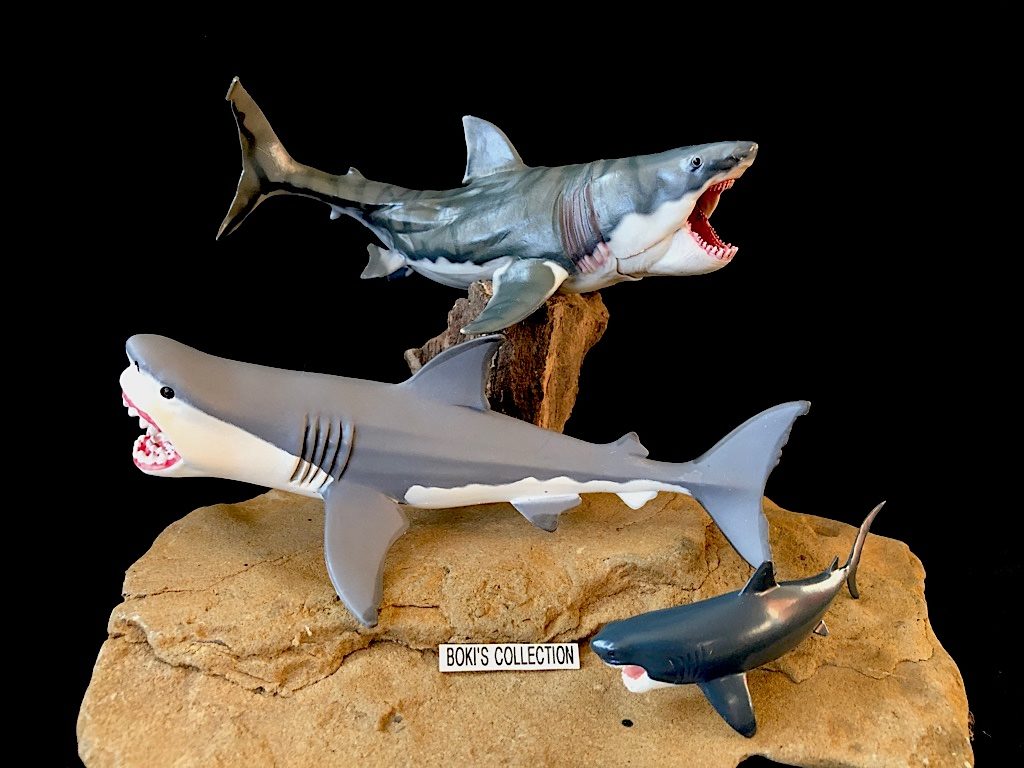
You would think that with its popularity, there would be more “official” megalodon toy figures out there. Surprisingly, there aren’t really that many produced ( at least that I am aware of).
Again, the way it has been depicted as an overgrown Great white shark on steroids may have something to do with the lack of official megalodon figures.
Looking at most of the toy/replica reconstruction currently available, there is very little to distinguish the two except for the size, so its easy to understand why there isn’t that many official Megalodon figures, after all, why waste production budget on something that looks like something else that has already saturated the market?
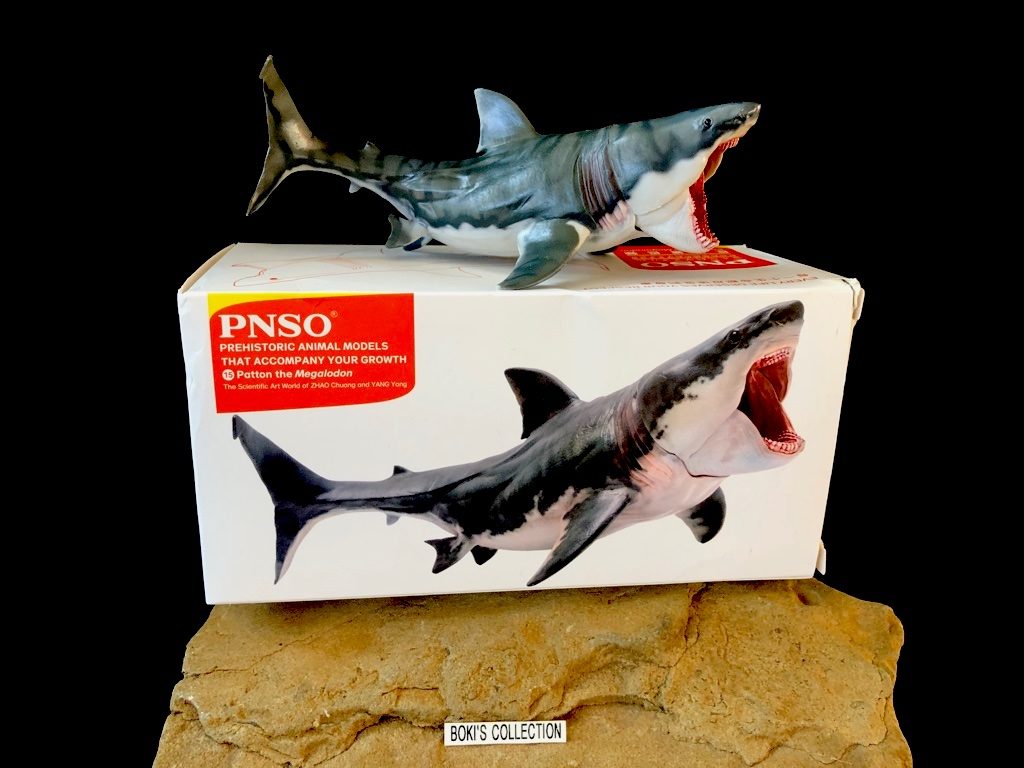
So let’s take a look at one of the few official Megalodon figures currently out, this one is from PNSO, one of two figures from them.
This figure from PNSO is the last version of Megalodon from any of the major brands, only released this years (2019). (As of this writing, CollectA just announced that they are releasing a Megalodon for 2020)
The figure is the second from PNSO; they released a much larger version or Megalodon way back when they first started. I don’t have that figure, it is one of the few from their original large set that I don’t own. Part of their newer line of smaller sized figure in their Prehistoric Animal Models That Accompany Your Growth series that, to-date, have five figures so far, all impressive.
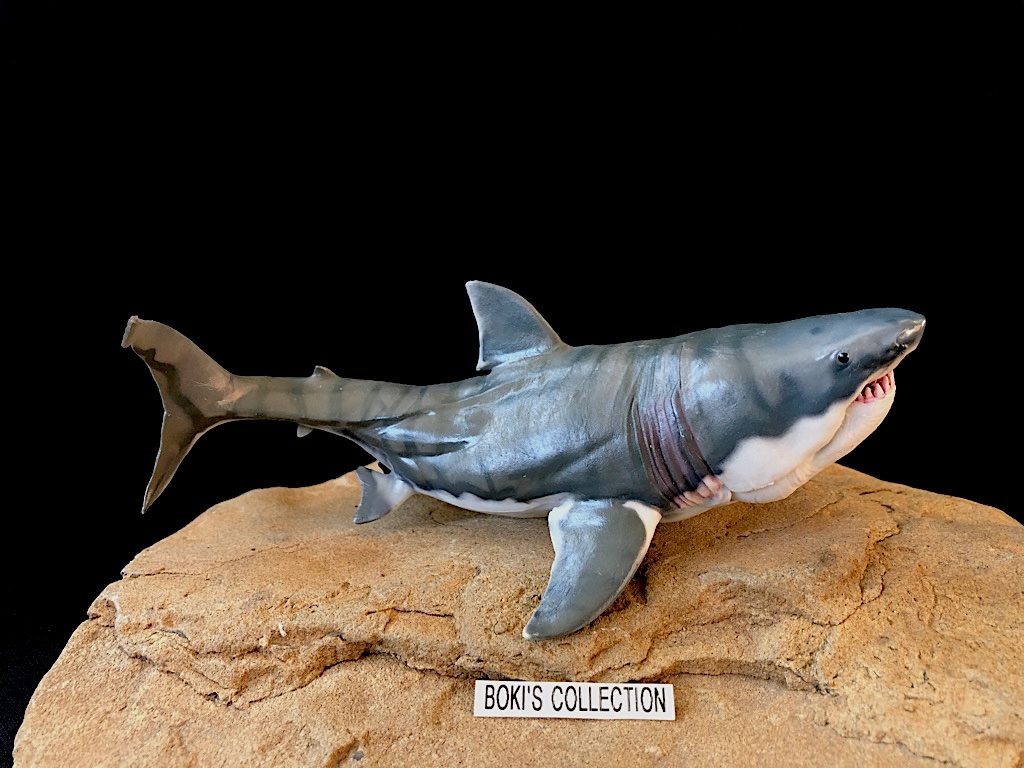
The figure measures 7.5” inches long when stretched out and roughly 3” tall, so it is much smaller, almost half the size of the original model that.
As expected, the first impression upon seeing the model is that it looks like a Great White shark, but PNSO have tried to at least make it a little less great white looking compared to other models out there, more on that later.
It is an impressive figure sculpt-wise. While many shark figures are often sculpted in a static rigid pose, this figure is in a very dynamic and active pose that really offers a lot of room for creativity for how you would want to display it.
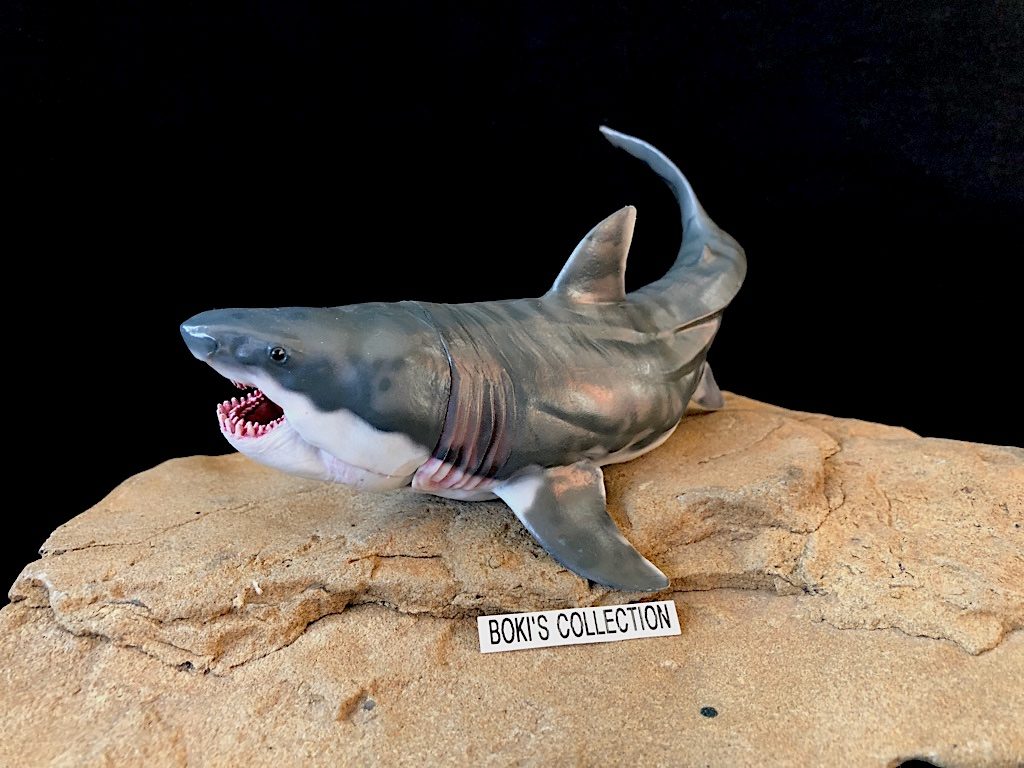
The figure comes with an articulated jaw, something that is challenging to execute successfully in sharks due to their unique dentition and shape of their mouth. I have to say that I have actually come to appreciate the way the jaw’s articulations were executed. The first time I saw the photos, I was not a fan. But having the figure in hand and really playing with the different stages the mouth can be opened really gave me a new admiration for this figure.
Due to the articulation, the seams are much more visible when the mouth is closed. But when you open it to its maximum, the seams tend to be not as visible. Before, I have preferred the mouth wide open, but now, I have come to appreciate having the mouth closed, to me, the inevitable visibility of the seams is a minor trade off for flexibility. The head is sculpted nicely with visible muscles, and you can also see the same musculature on the lower jaw especially when the mouth is closed.
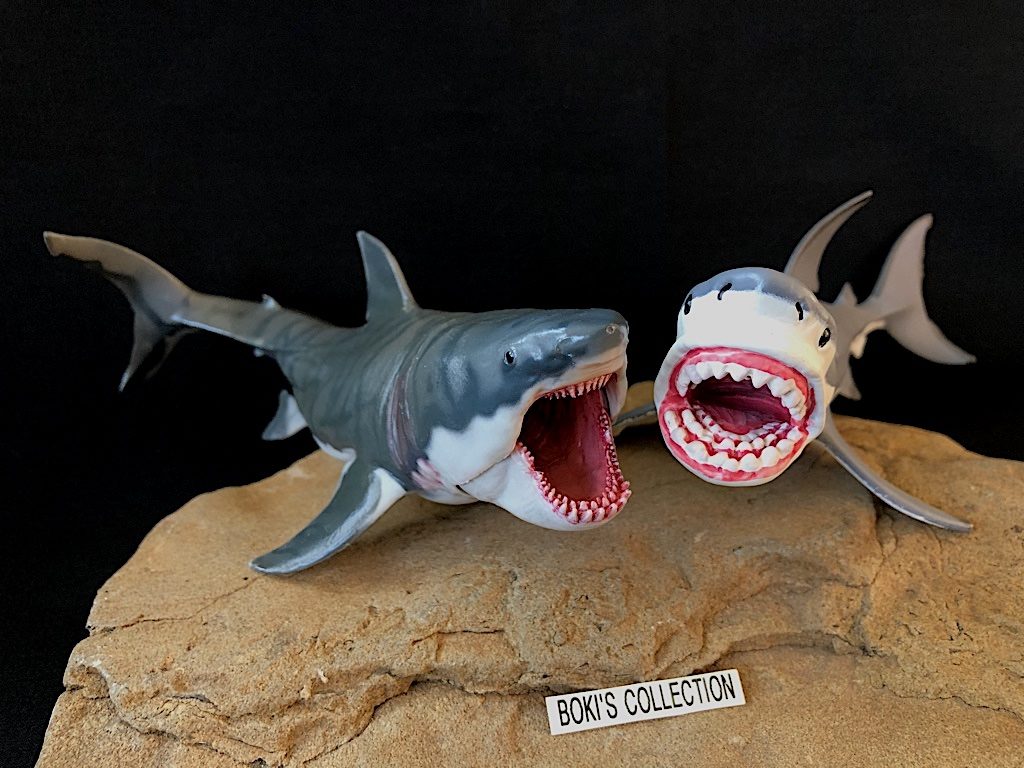
On the head, we see the first attempt to make it less great white. The snout is shorter and rounder than that of the great white.
Perhaps the most impressive part of this figure are the rows of teeth. The level of details is simply amazing for a figure of this scale. We often see in Megalodon and great white figures that the teeth are oversize and often blunted.
Not so on this figure. Both the upper set and lower set of teeth are appropriately in scale to the figure and they are individually sculpted, from the biggest outer rows, to the smallest ones on the back row, and all are cleanly painted, truly impressive attention to detail, something you have to really see in person to really appreciate the level of craftsmanship .
And if you look inside the mouth, you can even see details of the gill opening.

To be able to bite its large prey, Megalodon is believed to have been able to really open its mouth wide. The figure captures this feature very well. You can pose the mouth at various stages from completely closed, partially closed/open, all the way to its maximum wide gape, all done smoothly, an impressive articulation indeed.
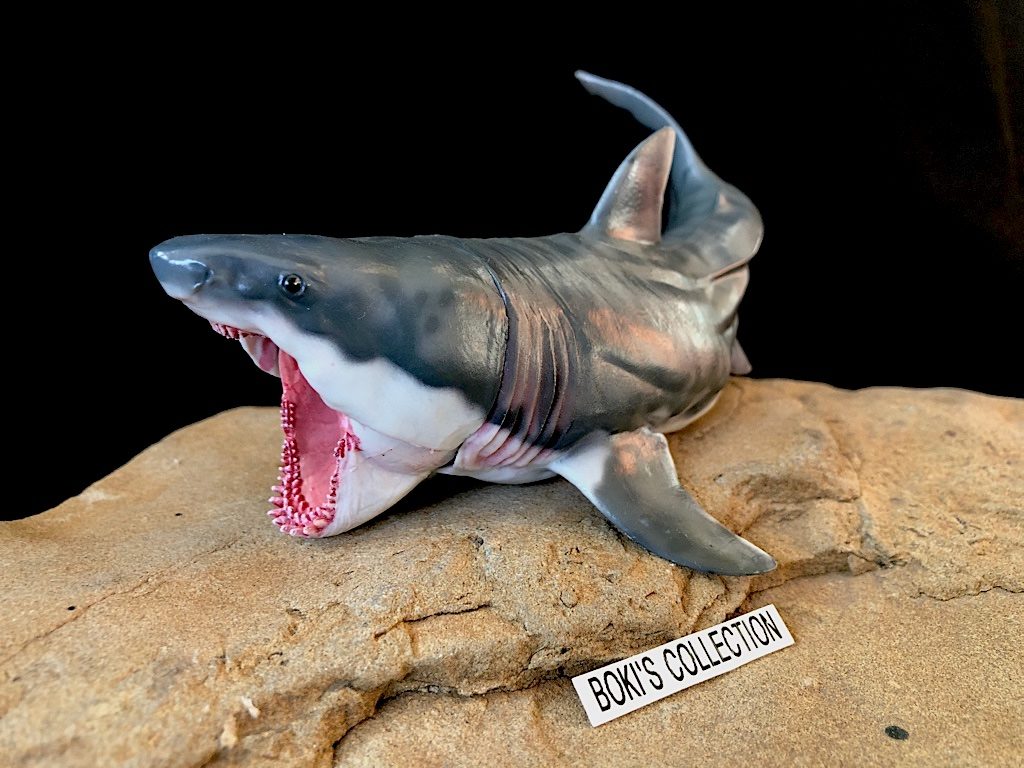
The eyes are small and painted black, looks back at you with a cold stare. You can see the nostrils towards the tip of the snout. If you look closely, you can see very fine skin detailing in the form or lines and wrinkles, nothing too extreme. There is also a nice texture on the skin that captures the sandpaper-like shark skin.
The gills are wrinkly and there appears to be six slits.Oddly, there is a pinkish highlights on the gills, I’m not sure if this was intended to be blood from its prey or fleshy underside of the gills showing, but the effects looks like the animal’s gill is bleeding
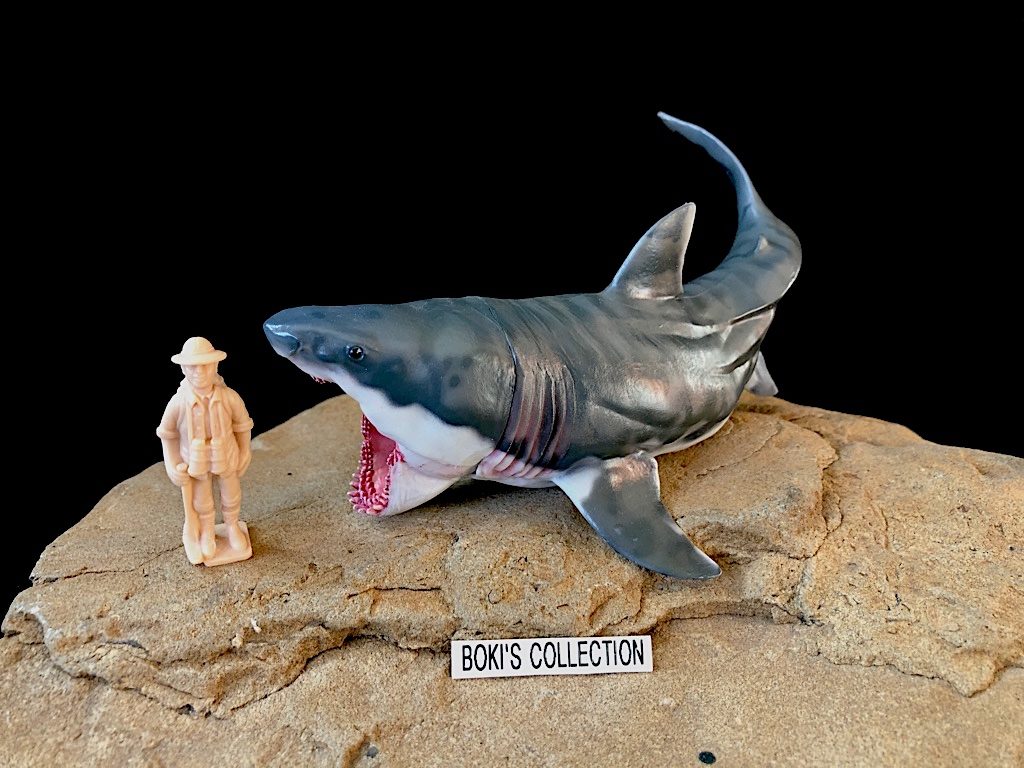
Moving on to the body, in general the proportion is a lot bulkier and shorter when compared to a Great white, so this is another area where PNSO tried to make it a little more distinct. The dorsal fins are also shorter and rounder, the same goes with the pectoral fins. The tail looks a little small in proportion to the rest of the body and also looks narrower. There is notch on the tip of the tail.
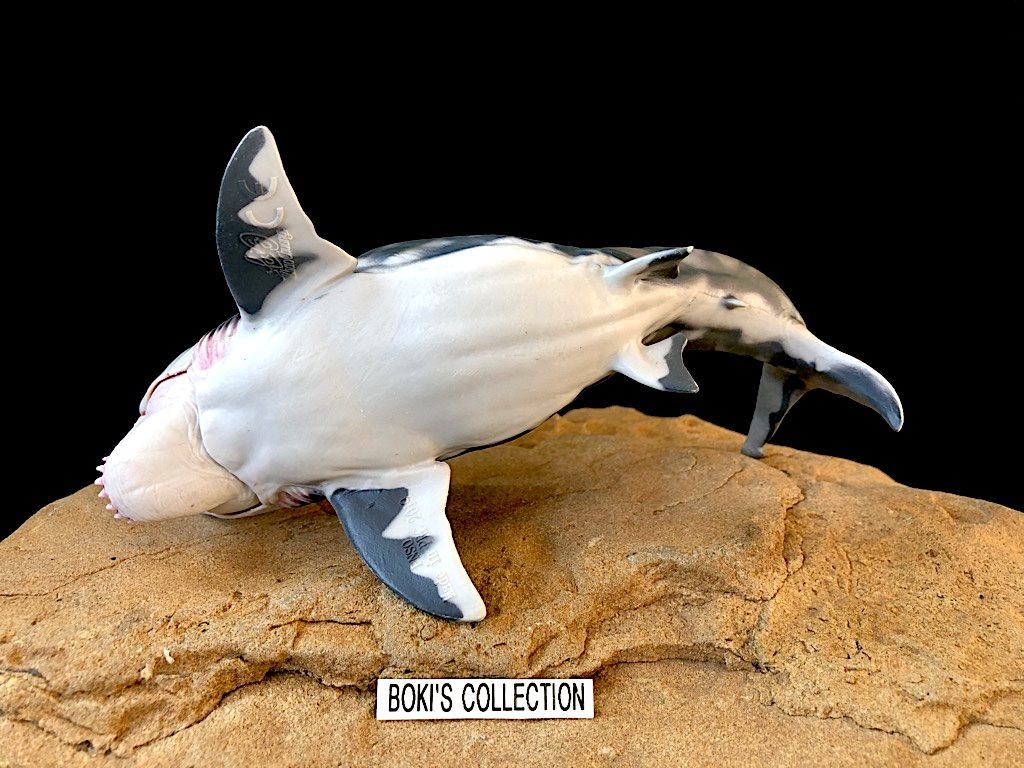
The dorsal and pectoral fins also looks shorter. And looking on the underside, this is a female shark, easily identifiable due to the lack of claspers.
The tail is sculpted actively, twisting to one side and you can see the tail base muscles clearly straining due to the weight, although I’m not sure if this is something that can be seen in today’s sharks.
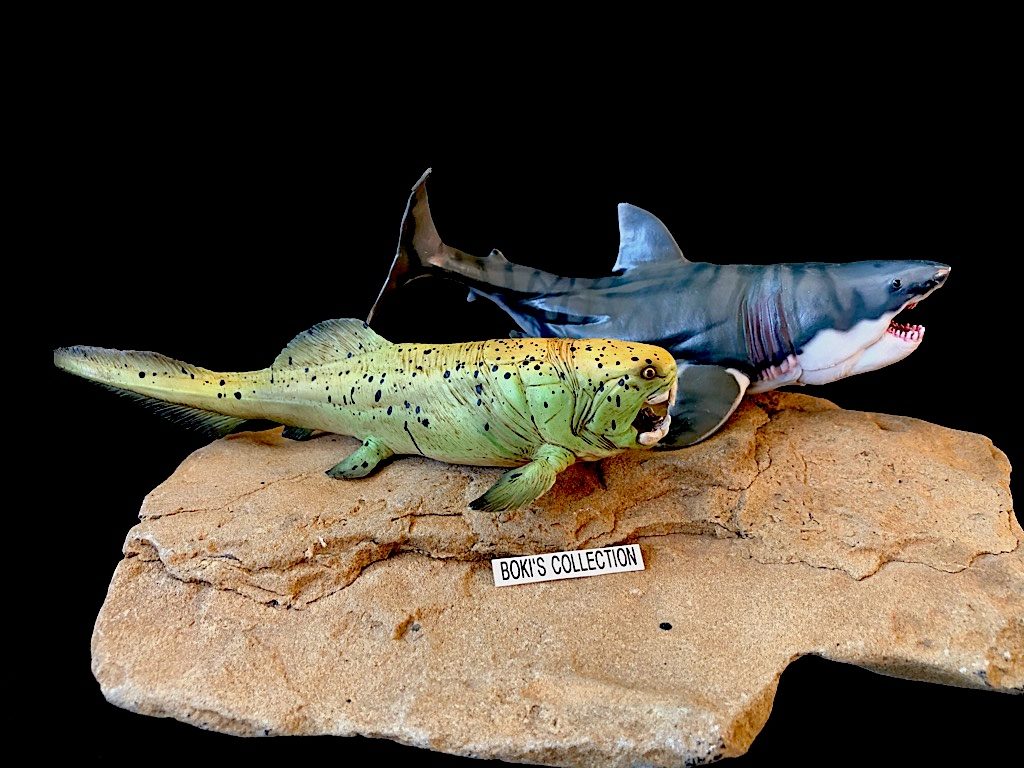
Now we come to the colors. This is another area where PNSO made an attempt to make it less Great white-like, although the gray and white division is still carried over and follow the exact patter.
What PNSO added are darker stripes on the back, from the head all the way down the tail and fins. This really gives it a more distinctive color patter from that of the Great white and more of that of the tiger shark. In addition, there are lighter brown highlights alternating between these dark stripes. These are all great attempt to differentiate it from the Great white but fell short and really not enough to make it stand out as a different species.
Of all the things that could really set megalodon from the Great white, the color is the best way to really achieve that, after all, we don’t have any idea of what the real animals colors are. This lack of evidence is the perfect way to be really creative.
Heck , even giving it the simple yet striking Orca whale or Bamboo shark colors would really set it apart and will cause you to stop and take a double look at the figure instead of just assuming its just another run of the mill Great white figure.
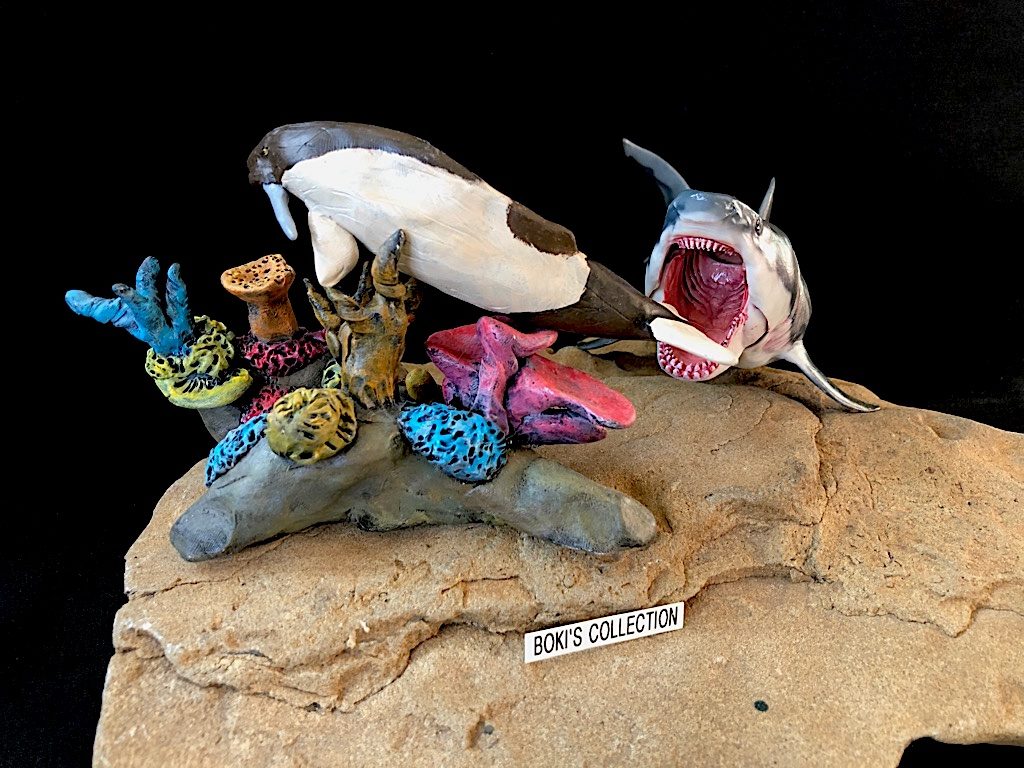
A good example of how color could really set the standards and make a species stand out is the case of the WWD Black and White Liopleurodon. When it debut, the black and white colors were so striking and different from other marine reptiles seen to date at that time that it really left no mistaking the animal for another marine reptile.
Since then, almost all of the major brands, from CollectA to Safari gave their own versions of Liopleurodon the same color scheme.
Something similar needs to happen with poor Megalodon to really make it its own instead of a wannabe of something else.

So, when popular reconstruction of this mighty predator is often ending up looking like the extant great white shark, is there a need to really produce an official Megalodon figure?
Absolutely. Such popular, large, and fascinating animal should and deserves to have an official figure. And we need more prehistoric fishes, too.
That being said, Megalodon, also deserves proper treatment. If an official Megalodon is to be produced, my opinion is that it should be made to look distinct and uniquely Megalodon and not just another great white or any other shark for that matter. This impressive beast deserves it’s own unique look instead of just looking like an overgrown shadow of its extant superstars cousin the Great white.
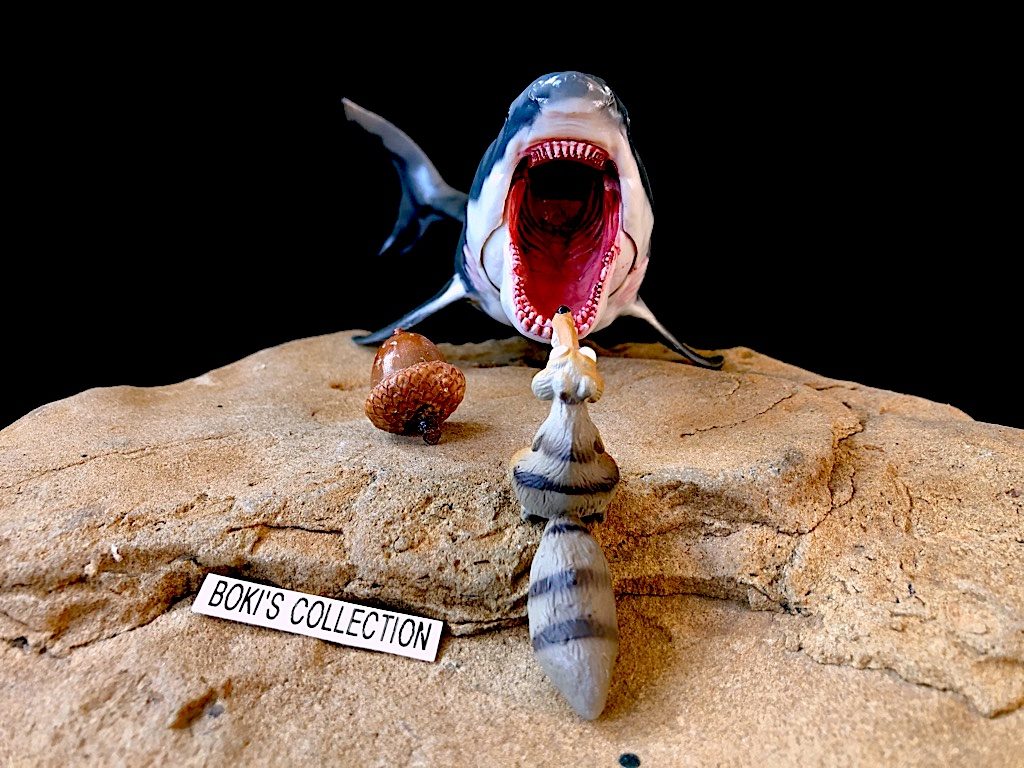
Well, that concludes this review, hope you enjoyed it and thanks for reading. Until next time, take care. Cheers!
Disclaimer: links to Ebay and Amazon on the DinoToyBlog are affiliate links, so we make a small commission if you use them. Thanks for supporting us!





This is a good review, and I think this is mostly a nice figure, although the jaw articulation looks hopelessly silly. Where I differ from you is on the necessity of making megalodon figures at all, when hundreds of other prehistoric fishes known from good remains, and often with bizarre anatomy, have never been made by the major manufacturers. If they are made, it’s almost always in miniature/Toob form; among major companies, Dunkleosteus and this shark are literally the only exceptions (Takara Tomy’s Dinosaur Train line did make a bright lavender/lime green Cretoxyrhina). I’d much rather see a Helicoprion, a Ctenacanthus, a Rhizodus, an Onychodus, a Pterichthyodes, a Titanichthys, a Bonnerichthys, etc., etc.
Yeah, I’m with you. I’m hoping that now that they did the two most popular prehistoric fish, that maybe they will move on to some of the more obscure or not as famous species, after all it’s CollectA’s- the company known for bringing us obscure species!
I would be in heaven if they released as a
Halicoprion as their next prehistoric shark and Leedsicthys as the next body prehistoric fish!
Thanks for that thoroughly review of a great figure.
I am not too deep into Megalodon as a species, but from my general knowledge about ecology I think it is a daring feat to produce a Megalodon figure that is true to the suspected ecology aswell as distinct enough so the general public will recognize it. PNSO did the job in this one I think – rounded snout, eyes set further back, shorter, much bulgier rump, distinct coloration, all within the small window of making ecological sense and still discriminating it from something else. I mean, you not even need to go to the prehistoric… how can a layman tell apart a nile from a saltwater croc.. Schleich sells their`s under both names 😀
I have the Safari figure and have thought about replacing it with the PNSO one someday, but now that CollectA is releasing one…
The megalodon sculpture of PNSO is beautiful but what spoils the figure is its articulated jaw the seams in the head are very noticeable.
Terrific review. Patton certainly has personality, and she’s easily superior to the Safari version. And while she does look wonky when her mouth is open wide, PNSO deserves props for the effort.